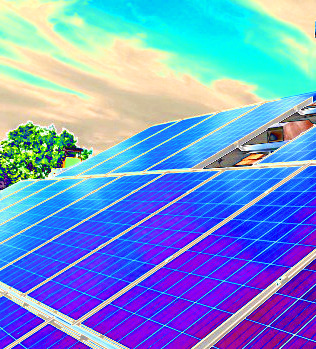Double win for dual-use roof
 A new study has shown the advantages of combining green roofs with solar setups.
A new study has shown the advantages of combining green roofs with solar setups.
The benefits of combining solar panel installations with green roofs appears to have been confirmed by new research, which demonstrates significant improvements in energy production, stormwater filtration and most surprisingly, a major increase in animal biodiversity.
Undertaken in Barangaroo in central Sydney, researchers compared the conventional photovoltaic (PV) solar system on International House with a combined PV solar and integrated green roof system (biosolar roof) on Daramu House over an eight-month period that spanned summer and winter.
“We utilised a unique experimental design, where the presence of the green roof was the sole variable, with both study sites in the same geographic location and of the same height, size, and shape,” said chief investigator Dr Peter Irga.
The research found that surface temperatures on the green roof were significantly lower, in some cases by up to 20°C during summer.
This improved the solar energy output by 3.6 percent, equating to $2,595 over the eight-month duration of the project.
“The efficiency of solar panels decreases when temperatures rise above 25°C, so by bringing down the surface temperature on typical hot Sydney summer days, the green roof enables the solar PV system to generate more electricity,” said Dr Irga.
“The surface temperature reduction shows how green roofs could play an important part in combating the urban heat island effect, a major issue in our cities.”
The green roof also absorbed almost nine tonnes of greenhouse gases, the equivalent of planting 110 trees.
While many of the results confirmed predicted benefits, the level of biodiversity observed on the city rooftop took the researchers by surprise.
“Animals thrived on the green roof, with insect and bird life increasing seven and fourfold, respectively,” said principal investigator Dr Robert Fleck.
“Our camera traps recorded images of the native Australian Blue Banded bee, Australian stingless bees, as well as Spotted Doves and Australian Ravens.
“The most exciting discovery was of a deceased bird that appeared to have been attacked by a predatory bird such as a peregrine falcon, which suggests that the urban roof is supporting complex food web systems,” said Dr Fleck.
Additionally, stormwater modelling on both roofs showed the biosolar roof could reduce flows into stormwater drains by more than 600L per second compared to the conventional roof.
“This shows that green roofs are a powerful tool in reducing the impacts of flooding during storm events, particularly where climate instability is leading to longer, drier periods and more intense storm events,” said Dr Irga.
Insulation was another benefit of the integrated system, preventing heat transferring inside the building as well as retaining heat in cooler periods.
The full study is accessible in PDF form, here.







 Print
Print